
Flow control equipment manufacturer Flowserve (NYSE: FLS) missed Wall Street’s revenue expectations in Q3 CY2025 as sales rose 3.6% year on year to $1.17 billion. Its non-GAAP profit of $0.90 per share was 13.2% above analysts’ consensus estimates.
Is now the time to buy Flowserve? Find out by accessing our full research report, it’s free for active Edge members.
Flowserve (FLS) Q3 CY2025 Highlights:
- Revenue: $1.17 billion vs analyst estimates of $1.21 billion (3.6% year-on-year growth, 2.7% miss)
- Adjusted EPS: $0.90 vs analyst estimates of $0.80 (13.2% beat)
- Management raised its full-year Adjusted EPS guidance to $3.45 at the midpoint, a 3.8% increase
- Operating Margin: 6.7%, down from 9.1% in the same quarter last year
- Free Cash Flow Margin: 32.8%, up from 13.6% in the same quarter last year
- Backlog: $2.9 billion at quarter end, up 3.8% year on year
- Market Capitalization: $6.91 billion
“Flowserve delivered another quarter of exceptional performance highlighted by strong revenue growth, significant margin and earnings expansion, and robust cash generation. This performance enabled us to repurchase over $140 million shares during the quarter. Consistent execution of our strategy has enabled us to maintain momentum, led by the strength of our aftermarket franchise and a resurgent Power and Nuclear end market fueled by growth of AI, increasing data center development, and broader electrification trends. We remain focused on leveraging the Flowserve Business System and our 80/20 initiatives to accelerate margin expansion, deliver outsized growth, and execute with excellence,” said Scott Rowe, Flowserve’s President and Chief Executive Officer.
Company Overview
Manufacturing the largest pump ever built for nuclear power generation, Flowserve (NYSE: FLS) manufactures and sells flow control equipment for various industries.
Revenue Growth
A company’s long-term sales performance can indicate its overall quality. Any business can put up a good quarter or two, but the best consistently grow over the long haul. Regrettably, Flowserve’s sales grew at a sluggish 4.2% compounded annual growth rate over the last five years. This fell short of our benchmark for the industrials sector and is a poor baseline for our analysis.
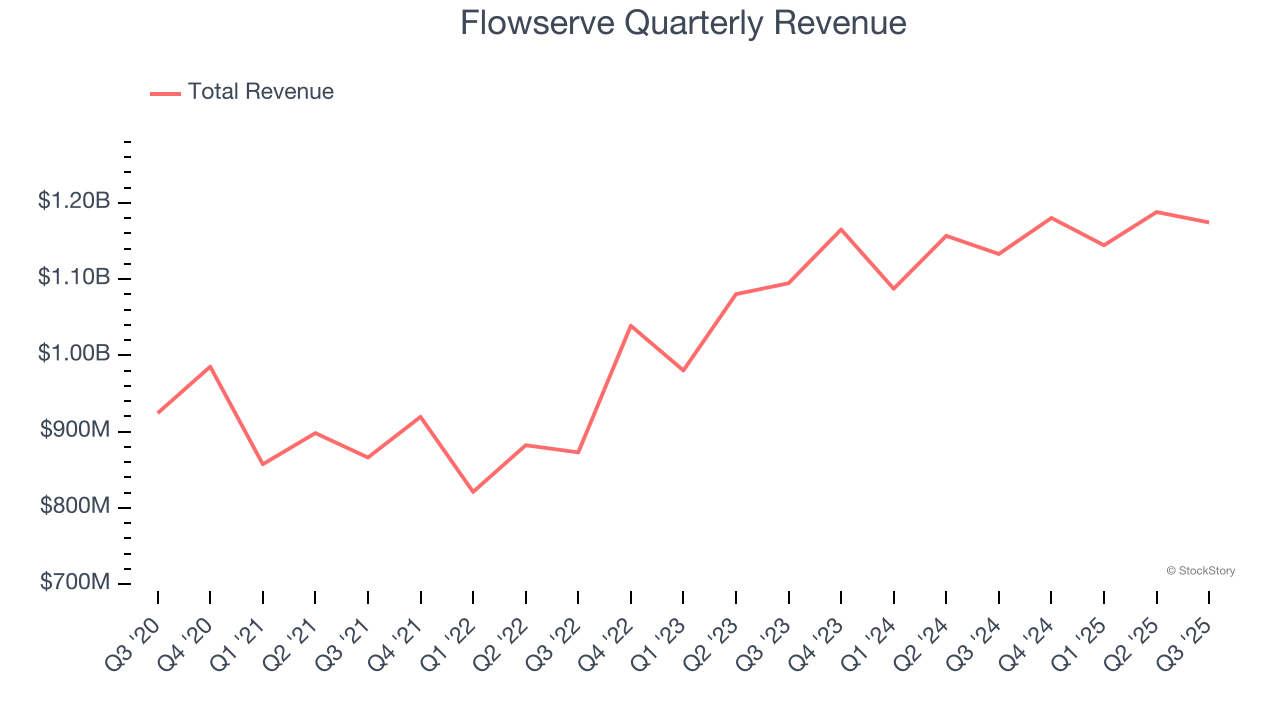
Long-term growth is the most important, but within industrials, a half-decade historical view may miss new industry trends or demand cycles. Flowserve’s annualized revenue growth of 5.7% over the last two years is above its five-year trend, but we were still disappointed by the results. 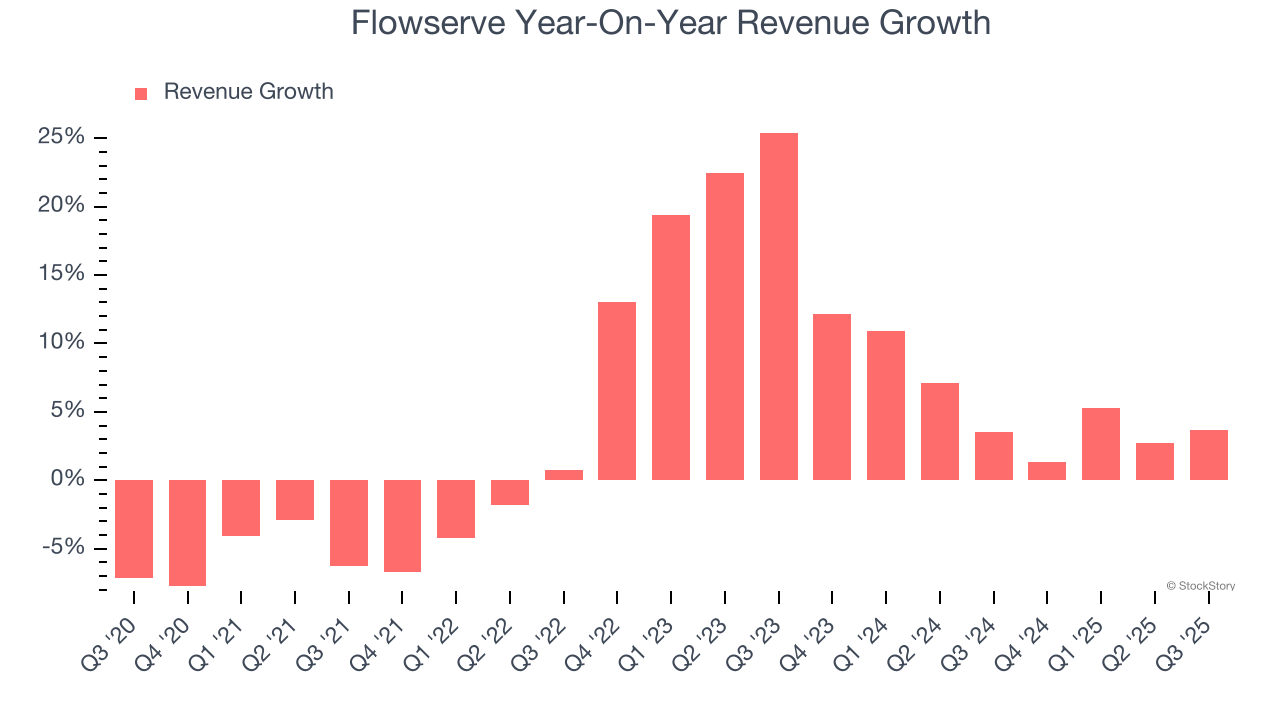
We can better understand the company’s revenue dynamics by analyzing its backlog, or the value of its outstanding orders that have not yet been executed or delivered. Flowserve’s backlog reached $2.9 billion in the latest quarter and averaged 1.2% year-on-year growth over the last two years. Because this number is lower than its revenue growth, we can see the company hasn’t secured enough new orders to maintain its growth rate in the future. 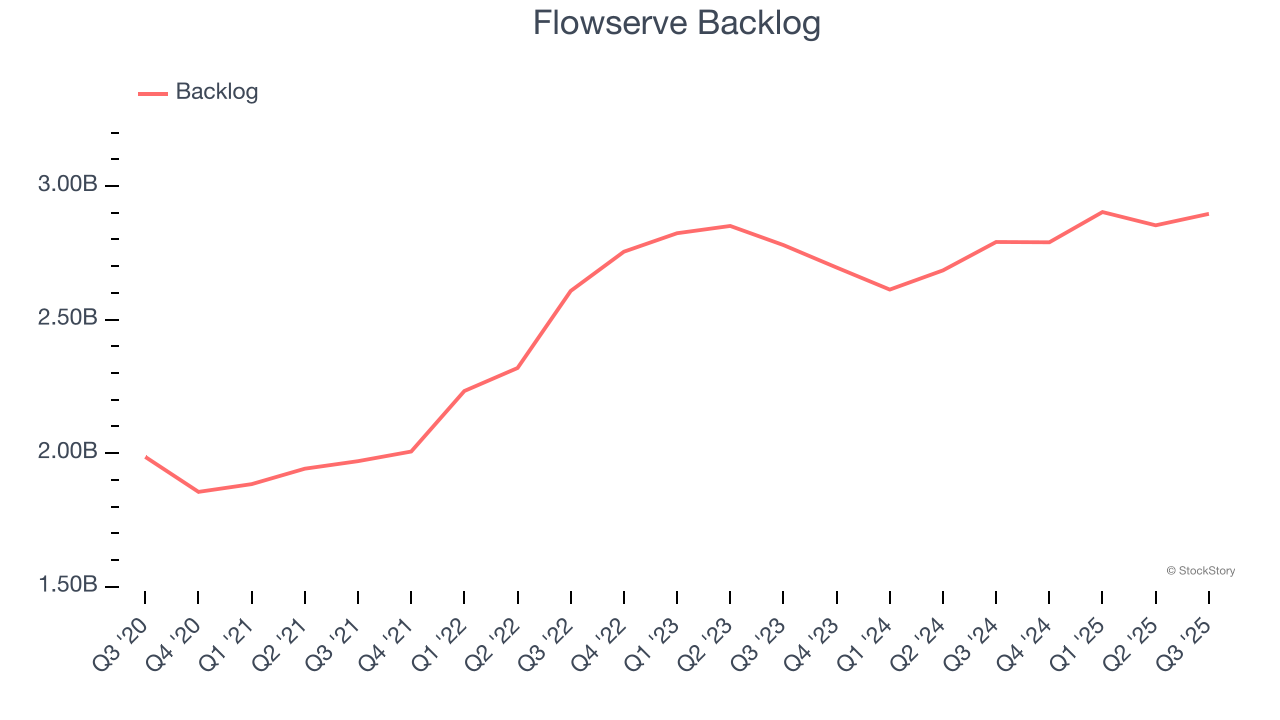
This quarter, Flowserve’s revenue grew by 3.6% year on year to $1.17 billion, falling short of Wall Street’s estimates.
Looking ahead, sell-side analysts expect revenue to grow 6% over the next 12 months, similar to its two-year rate. This projection is underwhelming and implies its newer products and services will not lead to better top-line performance yet.
Unless you’ve been living under a rock, it should be obvious by now that generative AI is going to have a huge impact on how large corporations do business. While Nvidia and AMD are trading close to all-time highs, we prefer a lesser-known (but still profitable) stock benefiting from the rise of AI. Click here to access our free report one of our favorites growth stories.
Operating Margin
Flowserve has done a decent job managing its cost base over the last five years. The company has produced an average operating margin of 8.4%, higher than the broader industrials sector.
Analyzing the trend in its profitability, Flowserve’s operating margin rose by 2.5 percentage points over the last five years, as its sales growth gave it operating leverage.
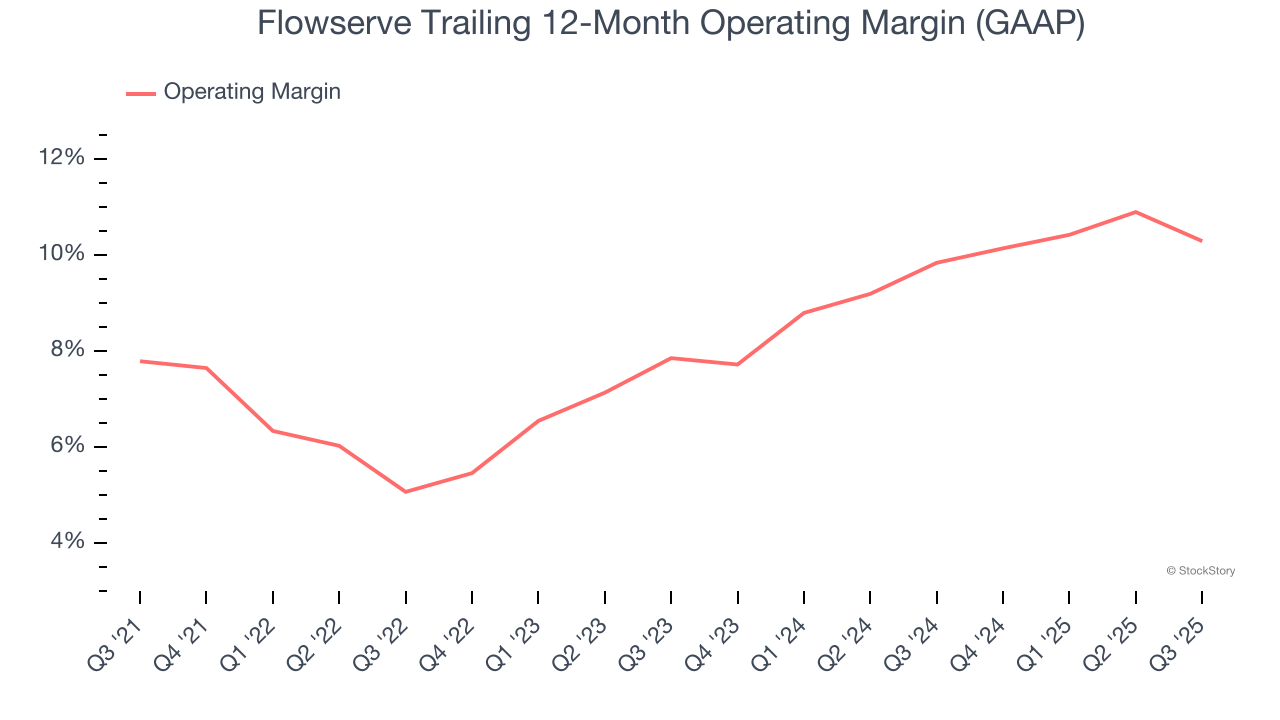
This quarter, Flowserve generated an operating margin profit margin of 6.7%, down 2.4 percentage points year on year. Since Flowserve’s operating margin decreased more than its gross margin, we can assume it was less efficient because expenses such as marketing, R&D, and administrative overhead increased.
Earnings Per Share
Revenue trends explain a company’s historical growth, but the long-term change in earnings per share (EPS) points to the profitability of that growth – for example, a company could inflate its sales through excessive spending on advertising and promotions.
Flowserve’s EPS grew at a solid 10.5% compounded annual growth rate over the last five years, higher than its 4.2% annualized revenue growth. This tells us the company became more profitable on a per-share basis as it expanded.
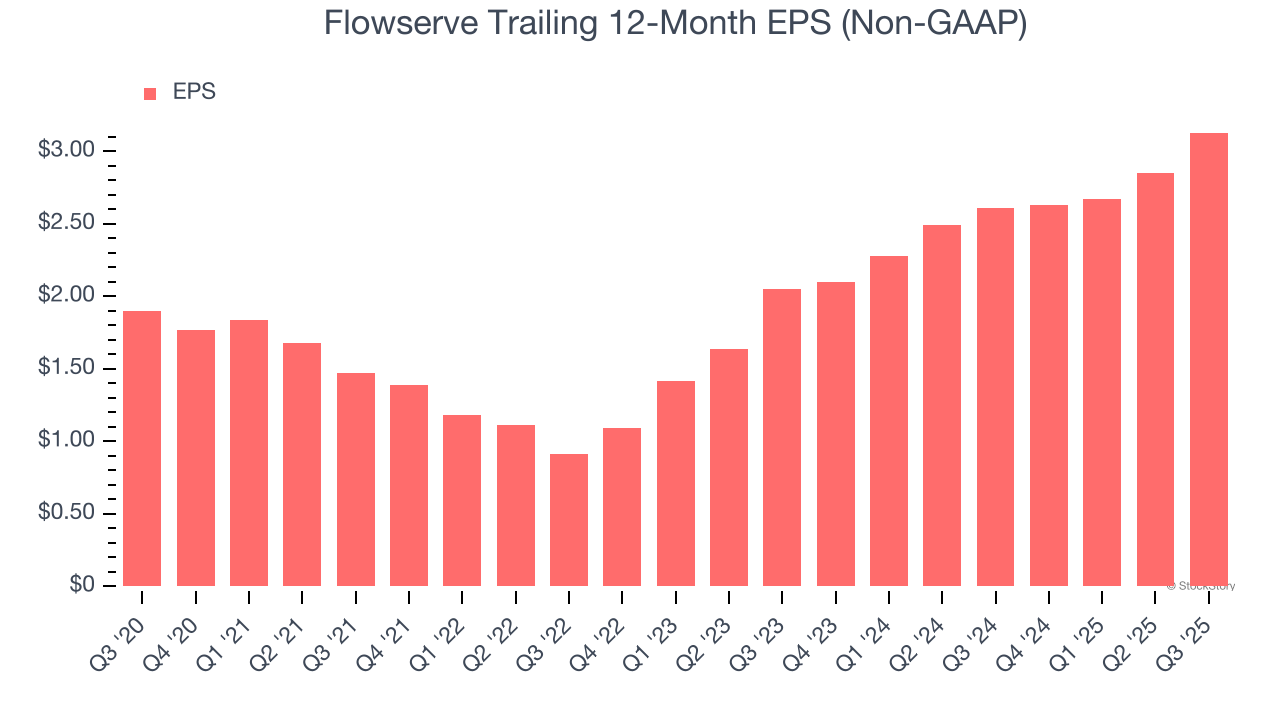
Diving into the nuances of Flowserve’s earnings can give us a better understanding of its performance. As we mentioned earlier, Flowserve’s operating margin declined this quarter but expanded by 2.5 percentage points over the last five years. This was the most relevant factor (aside from the revenue impact) behind its higher earnings; interest expenses and taxes can also affect EPS but don’t tell us as much about a company’s fundamentals.
Like with revenue, we analyze EPS over a more recent period because it can provide insight into an emerging theme or development for the business.
For Flowserve, its two-year annual EPS growth of 23.6% was higher than its five-year trend. We love it when earnings growth accelerates, especially when it accelerates off an already high base.
In Q3, Flowserve reported adjusted EPS of $0.90, up from $0.62 in the same quarter last year. This print easily cleared analysts’ estimates, and shareholders should be content with the results. Over the next 12 months, Wall Street expects Flowserve’s full-year EPS of $3.13 to grow 16.5%.
Key Takeaways from Flowserve’s Q3 Results
We were impressed by how significantly Flowserve blew past analysts’ backlog expectations this quarter. We were also glad its full-year EPS guidance exceeded Wall Street’s estimates. On the other hand, its revenue missed. Overall, we think this was a solid quarter with some key areas of upside. The stock traded up 4.5% to $55 immediately after reporting.
Flowserve may have had a good quarter, but does that mean you should invest right now? What happened in the latest quarter matters, but not as much as longer-term business quality and valuation, when deciding whether to invest in this stock. We cover that in our actionable full research report which you can read here, it’s free for active Edge members.


















